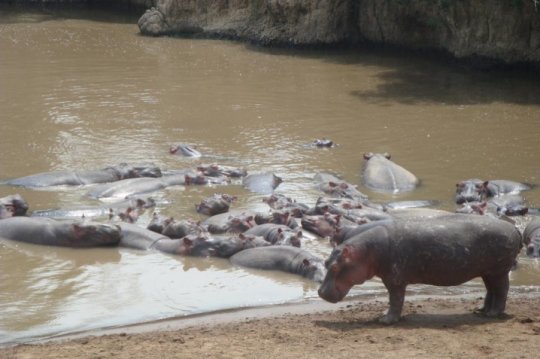[ad_1]
The excrements of hippos play an important role in the ecosystem of African lakes and rivers. Because there are fewer and fewer hippos, this ecosystem is in danger. In the long term, this could lead to food shortages at Lake Victoria, for example. These are some of the results of a new study by an international team of researchers published in the journal Science Advances. Patrick Frings from the German Research Centre for Geosciences GFZ is part of the research team behind it.
Wild hippos have a unique lifestyle: at night they eat dozens of kilograms of fresh grass in the savannahs. Most of their days they spend relaxing together in rivers or lakes, far away from enemies and protected from the burning sun. While chilling in the water, however, their digestion becomes active. Thus, enormous quantities of hippo poo enter the water.
“Hippos differ from other large grazing animals in the savannah,” explains biologist Jonas Schoelynck from the University of Antwerp, the first author of the study. “The nutrients in the excrements of most grazers largely end up back in the savannah again, where they are reabsorbed by the plants. This is not the case with hippos: they act as a kind of nutrient pump from the land to rivers and lakes.” In the study now published, researchers around Schoelynck and Frings show that this pumping function can be crucial for life in water. The results come from an expedition to the nearly four hundred kilometre long Mara River in the Masaai Mara Nature Reserve in Kenya.
Hippo excrements examined in the lab
“The grass that hippos eat contains silicon,” explains Jonas Schoelynck. “The grass absorbs this silicon from the groundwater. It gives it the strength it needs, protects it from disease and, to a limited extent, from grazing by small animals.” Patrick Frings from the Geochemistry of the Earth’s Surface Section of the GFZ analysed the isotopic composition of silicon in samples of plants, water and hippo excrements in the laboratory. This type of analysis provides a kind of chemical fingerprint of a sample substance. “The isotope analysis enabled us to reconstruct the transport path of the silicon,” explains Frings.
The researchers showed that a large part of the silicon in the Mara River was transported there via hippos. In the investigated area in southwest Kenya, the grazing animals absorbed a total of 800 kilograms of silicon per day through the plants they ate. 400 kilograms per day ended up in the water via excretion of hippo faeces. Through various ecological mechanisms, the hippos’ silicon contribution influences over 76 percent of the total silicon transported along the Mara River, according to calculations by the researchers. Hippos are therefore a key factor in the biogeochemical silicon cycle of certain areas.
“Our results are completely new,” says Patrick Frings of the GFZ. “So far, it has not been assumed that grazing wild animals could have such an influence on the transport of silicon from land to lakes. This process is crucial for the entire land-water ecosystem. In the past, however, it has simply been overlooked.”
A world without hippos
According to the researchers, silicon is vital for certain organisms such as diatoms. These unicellular algae live in the water, produce oxygen and form the basis of the food chain in many water ecosystems. If a lack of silicon occurs, the diatomaceous algae population can collapse, with harmful consequences for the entire food web in the lake or river concerned, the researchers say.
The number of hippos in Africa has been drastically reduced in recent years due to hunting and loss of habitats and their function as animal silicon pumps has thus been partially lost, say the researchers. In recent decades, up to ninety percent of hippos in Africa have become extinct. “Lake Victoria, into which the Mara River flows, can survive for several decades with its current silicon supply,” says Jonas Schoelynck. “But in the long run there is probably going to be a problem. If the diatoms do not get enough silicon, they are replaced by pest algae, which have all sorts of unpleasant consequences, such as a lack of oxygen and the associated death of fish. And fishing is an important source of food for the people of Lake Victoria.
Story Source:
Materials provided by GFZ GeoForschungsZentrum Potsdam, Helmholtz Centre. Note: Content may be edited for style and length.
[ad_2]















